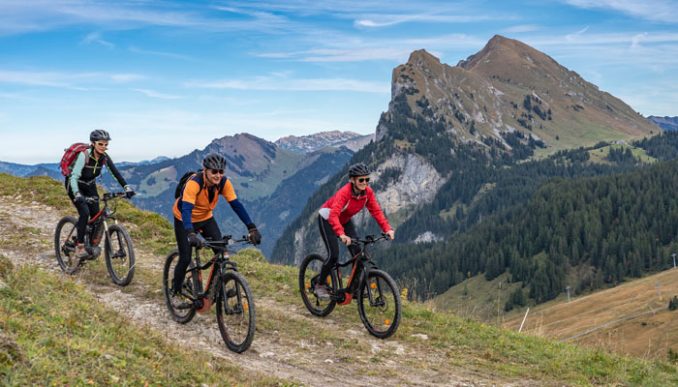E-Newsletter Signup
For special offers, updates and news of new products join our newsletter.
- Also in Blogs
- Sustainable Camping: Preserving Nature for Future Generations
- Embracing the Renewal of Spring: Camping Adventures Await.
- Beating The Winter Blues!
- The History of Cycling
- Senior Camping: Young at Heart
- View all posts in this category >>
GUEST BLOGGER
If you would like to contribute to our blog as a guest and can bring fresh outdoor experiences, please:
Winter Mountain Biking
Posted in Blogs on 25th October 2022
Mountain biking evokes a passion that’s like no other. The thrill of the sport is almost indescribable, as it means excitement, freedom and friendship.
If you love getting out and about to explore nature, relishing the thrill of going fast and accepting the challenges of different paths and obstacles, this is a way of taking cycling to the next level.

© Umomos / Shutterstock.com
While you may think of outdoor sports as something reserved for the summer, on the contrary, cycling is something you can do all year round. Winter mountain biking can be great fun, as long as you have the appropriate equipment to keep you safe and warm on your travels.
Whether you’re new to mountain biking and perhaps feel deterred by the colder weather, or you’re a seasoned pro who loves those crisp winter days, always make sure you’re prepared for the elements. You know what the good old fashioned British weather can be like!
How many people go mountain biking?
According to research, sales of bicycles in the UK rose by an estimated 22% during the pandemic in 2020, as people looked for ways to keep fit while having to work from home. At the end of 2021, 6.4 million people were cycling regularly in the UK, indicating good habits that started during the pandemic were continuing. A survey by Mintel revealed mountain bikes were the most popular type of cycle for adults in Britain, with 33% choosing them above other alternatives.
Industry experts say the UK’s love of cycling is continuing to grow, as the number of cyclists has increased by 28% since 2016. If it continues at its current rate, it’s predicted that by 2030, annual bicycle sales will be running at more than double new car registrations.
If you’re one of Britain’s millions of mountain bikers who will be continuing through frost, chilly winds and darker evenings, here are our handy tips on how to prepare.
Wear gloves
When mountain biking in winter, gloves are an absolute must. In fact, you should really be wearing gloves all year round for cycling and not just in cold weather. Your summer gloves should be designed for grip, while your winter gloves must aid grip, as well as keeping your hands warm.
Reduce tyre pressure
On winter days, you’ll be more prone to slipping off the trail, so as well as riding more slowly, let a little air out of your tyres too. Don’t go so low that your tyres feel obviously soft, as you’ll be more at risk of punctures. Experiment to see what feels right for you.
Check bike lights
As the nights get dark earlier, you may find yourself unexpectedly cycling home in darkness. Before going anywhere, make sure your lights are in full working order. Some modern bike lights are chargeable by USB, rather than having batteries, so make sure they’re fully charged before setting off.
Bright headlamps are an absolute must, not only so you can see where you’re going, but also to be seen by other road users.
Dress appropriately
When winter mountain biking, it’s not a case of simply putting on your warmest clothes. Wear several layers including a base layer, mid-layer, a cycling jersey, a fleece and a waterproof jacket that is lightweight enough to fold.
Take a backpack, so you can peel off the layers as you get warm, but put them on again if you feel chilly. Wearing waterproof socks and tights under baggy shorts will help keep the winter wind out.
Carry water
Just because the weather’s cold, it doesn’t mean you won’t need a drink. Take your usual supply with you, even if you don’t feel particularly thirsty. Keeping hydrated is vital, even in winter; if you become dehydrated, this can cause you to lose your energy and to start feeling dizzy and light-headed. This can be dangerous at any time of year.
Protect your eyes
Even if the weather’s fine as you set off, trails can quickly turn to mud once it starts to rain. Goggles can protect your eyes if the bicycle tyres are spitting up mud during your ride. You may get away with wearing glasses on a dry day, but if the weather turns nasty, they won’t protect your eyes in the same way that goggles will.
Know your route
While it can be fun to try new trails, in winter, it’s best to know and stick to your route. Do your research and try to ensure you’re not in a remote spot when it starts getting dark. If you’re thinking of tackling a new route, ideally, try to do so with friends. Riding with a group of people can also help keep you motivated.
You can find like-minded people by checking out the British Cycling website’s handy list of mountain biking clubs across the UK.
Explore
If you intend to transport your bike to new destinations, do so safely by using a bike carrier. Wherever you choose to cycle, always wear your helmet – it is estimated that the risk of severe head injury is significantly reduced by a whopping 69% and the risk of a fatal head injury is cut by 65%.
Once you’ve mastered cycling through the winter months, mountain biking in spring will be a doddle!



